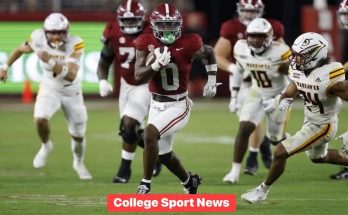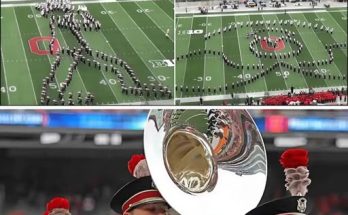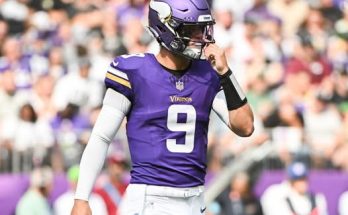After a disappointing Sunday night matchup between the Seattle Seahawks and the San Francisco 49ers, the spotlight quickly turned to Seattle’s quarterback, Sam Darnold, whose performance has sparked a wildfire of criticism from fans and analysts alike. The Seahawks’ loss, which came in a tightly contested game, seemed to hinge on several key moments where Darnold’s decisions and execution were underwhelming, leaving fans questioning the team’s direction and his role as a leader on the field. While Darnold has shown flashes of competence during his career, the mounting frustration from fans underscores a growing impatience with inconsistency at the quarterback position.
From the opening drive, it was clear that Seattle was struggling to find rhythm offensively. Darnold, who has had an up-and-down season, appeared hesitant in the pocket, frequently taking longer to make decisions and often under pressure from the 49ers’ aggressive pass rush. Several dropped opportunities and a critical interception in the second quarter amplified fan outrage, as social media erupted with posts criticizing his timing and decision-making. Analysts pointed out that while the offensive line provided some protection, Darnold’s mechanics and field awareness were inconsistent, leading to misreads that cost the team key yardage and momentum.
The Seahawks’ passing game, which has been touted as a potential strength, seemed unusually stagnant against San Francisco. Darnold struggled to connect with his receivers in crucial situations, missing open targets and failing to capitalize on designed plays. Fans, who have invested hope in the quarterback as a cornerstone for rebuilding, expressed disappointment not only in the execution but also in what they perceived as a lack of urgency. Many long-time supporters took to forums and social media platforms to voice concerns that Darnold’s performance reflects broader systemic issues with Seattle’s offensive strategy, including play-calling and adjustments against elite defenses.
While criticism has been fierce, some analysts urge a more measured perspective, noting that football is inherently a team sport and that blame cannot rest solely on Darnold’s shoulders. Injuries in the receiving corps and occasional breakdowns in blocking schemes contributed to the offensive struggles. Despite these mitigating factors, the narrative surrounding Darnold’s performance continues to dominate discussions, with fans drawing comparisons to other quarterbacks who have successfully elevated their teams in high-pressure situations. The pressure to perform is particularly intense in Seattle, a city with a passionate and often unforgiving fan base, and each loss seems to compound scrutiny.
Social media responses were particularly harsh following the game. Twitter, Instagram, and fan forums were flooded with posts dissecting Darnold’s throws, pocket presence, and overall composure. Some fans questioned whether he has the mental toughness required to lead the Seahawks to sustained success, while others speculated about potential changes to the team’s quarterback situation in future seasons. Hashtags trending throughout the evening reflected a mix of frustration, disappointment, and, in some cases, humor at Darnold’s expense. The intensity of the reaction demonstrates how much expectations have grown around the quarterback position, and how quickly public sentiment can shift in the face of perceived underperformance.
In addition to fan criticism, sports analysts and commentators weighed in, providing detailed breakdowns of Darnold’s mechanics and decision-making on individual plays. Some highlighted moments where he appeared to overthink options or hesitate, resulting in missed opportunities or turnovers. Others acknowledged that he faced one of the most formidable defensive fronts in the league and that mistakes were inevitable in such high-pressure circumstances. The consensus, however, is that while Darnold is not solely to blame for the loss, his performance was a significant factor in the Seahawks failing to secure a victory against a division rival.
Despite the negative feedback, there are voices within the community and the organization emphasizing the need for patience. They point out that Darnold has experienced moments of brilliance in past seasons and that the Seahawks’ offensive scheme has required adjustments following injuries and roster changes. Supporters argue that consistent playing time, chemistry with receivers, and tailored game plans could allow him to regain confidence and deliver performances more aligned with expectations. The narrative suggests that while fans’ frustration is understandable, outright condemnation may overlook the complexities of quarterback development in a competitive league.
The Seahawks’ coaching staff also bears a degree of responsibility. Critics argue that play-calling and in-game adjustments did not adequately support Darnold, particularly in third-down situations and red-zone opportunities. Some observers noted a reliance on predictable patterns that allowed the 49ers’ defense to anticipate plays and apply consistent pressure. Fans’ frustration, therefore, extends beyond Darnold himself, encompassing strategic decisions that they feel hindered his ability to perform effectively.
Looking forward, the loss to San Francisco serves as a critical moment for reflection for both Darnold and the Seahawks organization. The team faces a stretch of games where the margin for error is small, and sustained success will require cohesion, adaptability, and improved execution from all units, particularly the quarterback. For Darnold, this represents an opportunity to respond to criticism with improved focus, decision-making, and on-field leadership. How he handles the scrutiny and adjusts to the challenges ahead will likely determine both his future with the team and the trajectory of the Seahawks’ season.
In conclusion, Sam Darnold’s performance against the 49ers has ignited a heated reaction from fans, reflecting both disappointment and concern about the Seahawks’ offensive direction. While the quarterback faced challenges that partially mitigated his errors, public scrutiny has been intense, highlighting the high expectations and low tolerance for inconsistency in Seattle. As the team moves forward, the emphasis will be on accountability, adjustments, and resilience. Whether Darnold can silence critics and restore confidence in his leadership will be a key storyline, not just for the Seahawks’ season, but for his own career trajectory in a city that demands excellence from its quarterbacks.
The intensity of fan reactions underscores the passionate, results-driven culture surrounding NFL quarterbacks, particularly in markets like Seattle. Darnold’s journey is emblematic of the pressures athletes face at the highest level, where each performance is dissected and debated. As the season progresses, fans will undoubtedly continue to scrutinize his development, but there remains a window of opportunity for Darnold to prove that he can rise to the challenge and lead the Seahawks with consistency and poise. The question now is whether he will answer that call or continue to face the fire from a fan base hungry for victories.



